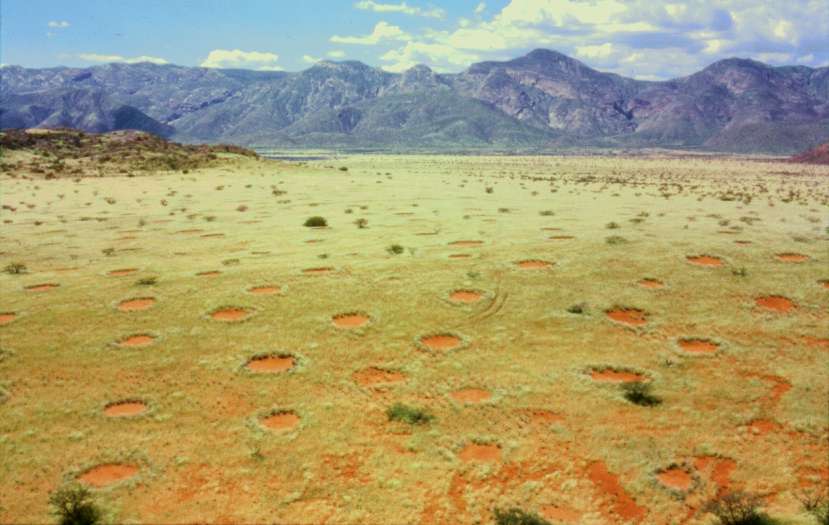
Fairy circles of hydrogen gas in Namibia’s Marienfluss valley photo by Thorsten Becker via Wikipedia
It came to him in a dream. Dmitri Mendeleev, the man who invented the periodic table and periodic law, faced poverty in Siberia, prejudice in Moscow, tuberculosis in St. Petersburg and the Crimean war while convalescing from tuberculosis. On her deathbed his mother cautioned: “Be careful of illusion; work, search for divine and scientific truth.”
In February 1869 he wrote the properties of some elements and played something like chemical solitaire to try to understand the pattern before falling asleep. Mendeleev later wrote: “In a dream I saw a table where all the elements fell into place as required. Awakening, I immediately wrote it down on a piece of paper.”
Hydrogen, the lightest and most abundant element in the known universe, remains where he wrote it, alone in the upper left corner of his periodic table of the elements. In 1888 Mendeleev measured 5.8 to 7.5% hydrogen gas seeping from cracks in the Makiivka coal mine in the Donetsk region of Ukraine. Chemists were well aware of hydrogen’s relationship to water when they named it hydrogen, but his was one of the first scientific measurements of geologic hydrogen.
Hydrogen as the perfect fuel
Fast forward to the 1970s when environmentalists were beginning to understand what Eunice Newton Foote and other 19th century scientists had predicted about the impact of carbon dioxide on our climate. Coal, wood, oil and natural gas all release carbon dioxide when they burned but hydrogen burns clean, producing only water vapor. The hydrogen economy hype seemed too good to be true. Our atmosphere isn’t pure oxygen so a hydrogen flame produces some nitrogen oxides (NOx) but it emits far less pollution that any hydrocarbon would. Scientists and environmentalists were in agreement, hydrogen is the perfect fuel!
Hydrogen hydrogen everywhere but not a molecule to burn
There is one problem. Where will we get the hydrogen? The sun is 73% hydrogen and Jupiter is 90% hydrogen but they’re hardly as convenient as your local gas station. Every molecule of water in the world’s oceans contains two parts hydrogen and one part oxygen. By mass the oceans are 10% hydrogen. But the hydrogen in H2O is stuck tightly to the oxygen so it takes energy to split the hydrogen from the oxygen in water. Electrolysis is a process which uses electricity to do this but efficiency levels are less than 70%. So it takes about six kilowatt-hours of electricity to split the hydrogen from oxygen in a 1-liter bottle of water. (See footnote below)
That would be enough to run a television and refrigerator for about ten hours. If that electricity comes from green or carbon neutral fuels we can consider this to be green hydrogen. Manufactured hydrogen isn’t a replacement for fossil fuels but it can be a useful way to store energy to be burned or used in fuel cells.
Geologic Hydrogen
But what if we didn’t have to split hydrogen from oxygen? What if there were places like the coal mine Mendeleev studied in Ukraine with an even higher percentage of hydrogen? Like the chemical patterns revealed in Mendeleev’s dream, so-called geologic hydrogen was there all along but we weren’t looking for it, or we were looking in the wrong places.
Most known hydrogen producing vents are in Eastern Europe and Russia because people there were looking, partly because Russian scientists had accepted an abiotic petroleum theory that required hydrogen instead of organic matter to create underground oil reserves. The western scientific belief that free geologic hydrogen was rare became a self-fulfilling prophecy. Hydrogen is often used as a carrier gas in chromatography instruments used to survey geologic gas. This made these instruments blind to geologic hydrogen.
Prospectors started looking harder in response to the energy shortage caused by Vladimir Putin’s invasion of Ukraine in 2022. One such source of “hidden” geologic hydrogen is where an eternal flame burns on Mount Chimaera in Turkey. In his second book of Historia Naturalis (77 AD), Pliny the Elder referred to writings by Ctesias in the fifth century BC suggesting that these vents which “burned with a flame that does not die by day or night” were the origin of the mythical fire-breathing lion-goat monster named Chimera. This is also believed to be the place where the original Olympic torch was lit. The torch in the 2020 Olympics in Tokyo Japan was lit from a cauldron that burned manufactured green hydrogen.

Photo of natural fires on Mount Chimaera, Turkey by Carole Raddato from FRANKFURT, Germany
How does geology create hydrogen?
The exact processes are not known for all sources of geologic hydrogen but some of the basic chemistry would’ve been known by 1904 when Howard Lane built a device that used a reaction between iron and steam to generate hydrogen. Lane’s process was used to inflate balloons for the St. Louis exposition and airships such as the Graf Zeppelin. There are places deep underground where water comes in contact with hot iron-bearing rock. The iron-rich mineral olivine is common in the earth’s mantle and when it comes into contact with water, a reaction called serpentinization occurs which takes oxygen from water and produces hydrogen and another mineral called Serpentinite.

Photo of serpentinite by Hermann Hammer
Other hydrogen generating reactions occur deep within the earth but some, such as radiolysis where the energy from radioactive decay splits water are thought to be too slow to produce useful amounts of hydrogen. The serpentinization reactions may be faster than the slow biological decay which produces coal and petroleum.
Follow the hydrogen faeries
The geology which favors coal, oil and tar-sands is not necessarily ideal for generating and trapping hydrogen. Hydrogen can escape or chemically bond with porous sedimentary rock and some microbes eat it. If high purity geologic sources of hydrogen are common enough to replace some fossil fuels, we may find ourselves in a new age of hydrogen prospecting.

I need to figure out how to prospect for hydrogen among the faery rings in this field about 50 meters from our house. 😉
Fortunately nature gives us some clues. Fairy circles are circular patches where grass and other plantlife is altered. Like the Chimera of Turkey, various legends tried to explain what caused them. In English and Celtic folklore said they were caused by faeries dancing in a circle and if a human joined them, they would be forced to dance until they passed out. We now understand that many are caused when trees, mushrooms, decaying stumps and other organic matter alter the soil. But they can also be caused by hydrogen seeping from underground cracks.
A Science.org article entitled Hidden Hydrogen by Eric Hand describes some recent discoveries of geologic hydrogen. One is by a man named Luke Titus who read a 1944 Geologic survey of South Australia during the Covid-19 lockdown. He learned about the use of divining rods and other unusual prospecting techniques and boreholes on Kangaroo island which produced up to 80% pure hydrogen. Mr. Titus acquired prospecting rights in the region and founded a company called Gold Hydrogen.
Other promising sources of geologic hydrogen have been found in Brazil, Namibia, Iceland, Canada, Finland and the US.
The Hidden Hydrogen article describes a 1987 discovery in Mali where a water-well driller was smoking near where wind came from the dry bore hole. He set off an explosion with a flame that was “…like blue sparkling water and did not have black smoke pollution. The color of the fire at night was like shining gold, and all over the fields we could see each other in the light.”
Another place where geologic hydrogen is well known are the black-smoker vents found where volcanic oceanic ridges meet the water of the deep ocean. The relative inaccessibility of this hydrogen is a reminder that there is a difference between knowing where hydrogen exists and being able to economically extract it without causing other unwanted environmental destruction.
For chemists, geologists and environmentalists, geologic hydrogen may be a flash in the pan, or it might be a new hydrogen “gold rush” that forever changes the world.
_____________
Footnote:
My father is a retired science teacher who once called the local power company after calculating how much electricity it would take to split enough water to generate enough hydrogen and oxygen to raise the Titanic. When company officials realized he wasn’t an industrial customer, they didn’t call him back. Assuming a 131186287 liter Titanic just below the surface and I get:
131186287L/1865L/ 6 kWh = 70,348kWh * 6 = 422,092kWh
422,092 kilowatt-hours * 0.12/kWh = $50,651
This is surprisingly inexpensive though this is only in the ideal case where an intact Titanic lies just beneath the surface, not where it sits on the bottom 3800 meters below. The inverse provides perspective the titanic volume of hydrogen and oxygen that must come together to produce 422,092 kWh of energy.
